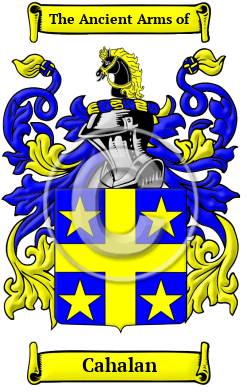| ![Show Contents]() Cahalan History, Family Crest & Coats of Arms Cahalan History, Family Crest & Coats of Arms
- Origins Available:
Ireland
Wales
Etymology of CahalanWhat does the name Cahalan mean? The name Cahalan has undergone many variations in the time that has passed since its genesis. In Gaelic it appeared as "O Croinin," which derives from the word "cron," which meant "brown" or "dark." 1 Early Origins of the Cahalan familyThe surname Cahalan was first found in County Cork (Irish: Corcaigh) the ancient Kingdom of Deis Muin (Desmond), located on the southwest coast of Ireland in the province of Munster. Saint Crónán (died 640) was the abbot-bishop and patron of the diocese of Roscrea. His feasy day is April 28th. Mo Chua or Crónán mac Bécáin (died 637) was the founder of Balla, which later merged into that of Tuam, Ireland. Apparently the two were not related. Temple Cronan is a ruined medieval chapel built near a holy well in the Burren, County Clare, Ireland. It dates from the 12th century and may have been originally built to serve as a pagan temple. The building looks to have been renovated in the 15th century, but it is thought that this stone structure replaced a wooden structure that is thought to have been founded by Saint Cronan. Early History of the Cahalan familyThis web page shows only a small excerpt of our Cahalan research. Another 130 words (9 lines of text) covering the years 1172 and 1659 are included under the topic Early Cahalan History in all our PDF Extended History products and printed products wherever possible. Cahalan Spelling VariationsIrish names recorded during the Middle Ages are characterized by many spelling variations. This preponderance of variations for common names can be explained by the fact that the scribes and church officials that kept records during that period individually decided how to capture one's name. These recorders primarily based their decisions on how the name was pronounced or what it meant. Research into the name Cahalan revealed many variations, including Cronin, Cronyn, Cronine, Croynin, Cronan, Cronnin, Cronnan, Cronnyn, Cronen, O'Cronin, Croynan and many more. Early Notables of the Cahalan familyMore information is included under the topic Early Cahalan Notables in all our PDF Extended History products and printed products wherever possible.
| Cahalan migration to the United States | + |
Suffering from poverty and racial discrimination, thousands of Irish families left the island in the 19th century for North America aboard cramped passenger ships. The early migrants became settlers of small tracts of land, and those that came later were often employed in the new cities or transitional work camps. The largest influx of Irish settlers occurred with Great Potato Famine during the late 1840s. Although the immigrants from this period were often maligned when they arrived in the United States, they provided the cheap labor that was necessary for the development of that country as an industrial power. Early immigration and passenger lists have revealed many immigrants bearing the name Cahalan:
Cahalan Settlers in United States in the 19th Century- Thomas Cahalan, who landed in Allegany (Allegheny) County, Pennsylvania in 1870 2
| Cahalan migration to New Zealand | + |
Emigration to New Zealand followed in the footsteps of the European explorers, such as Captain Cook (1769-70): first came sealers, whalers, missionaries, and traders. By 1838, the British New Zealand Company had begun buying land from the Maori tribes, and selling it to settlers, and, after the Treaty of Waitangi in 1840, many British families set out on the arduous six month journey from Britain to Aotearoa to start a new life. Early immigrants include: Cahalan Settlers in New Zealand in the 19th Century- Sarah Cahalan, who arrived in Auckland, New Zealand aboard the ship "Triumph" in 1883
| Contemporary Notables of the name Cahalan (post 1700) | + |
- Susannah Cahalan (b. 1985), American journalist and author, known for writing the memoir Brain on Fire, about her hospitalization with a rare auto-immune disease, anti-NMDA receptor encephalitis
- Robert F. Cahalan (b. 1946), American Emeritus Scientist at NASA Goddard Space Flight Center, and previous Chief of the Laboratory for Climate and Radiation (2003–2013)
- Sinéad Cahalan, Irish camogie player and teacher at Creagh National School who won Camogie All Star awards in 2005 and 2008 and played in the All Ireland final 2008, 2010 and 2011
- Cissie Cahalan (1876-1948), Irish trade unionist, feminist, and suffragette
- Adrienne Cahalan (b. 1964), Australian sailor, the only woman who competed in the 2005-2006 Volvo Ocean Race
- Vera Cahalan Bushfield (1889-1976), American Republican politician, U.S. Senator from South Dakota, 1948 3
- MacLysaght, Edward, Supplement to Irish Families. Baltimore: Genealogical Book Company, 1964. Print.
- Filby, P. William, Meyer, Mary K., Passenger and immigration lists index : a guide to published arrival records of about 500,000 passengers who came to the United States and Canada in the seventeenth, eighteenth, and nineteenth centuries. 1982-1985 Cumulated Supplements in Four Volumes Detroit, Mich. : Gale Research Co., 1985, Print (ISBN 0-8103-1795-8)
- The Political Graveyard: Alphabetical Name Index. (Retrieved 2016, January 12) . Retrieved from http://politicalgraveyard.com/alpha/index.html
 |

